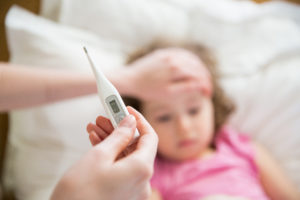When Is a Fever Too High for a Baby

Fevers ofttimes become a bad rap, particularly when it comes to children. Although they leave many parents worried, in most people, a fever is rarely dangerous. In fact, they are really a expert thing. Fevers are a natural mode that our bodies fight off infections by increasing the body's temperature in social club to make it more than hard for germs to alive and multiply. When it comes to kids' fevers, here is some helpful information to help you determine how high is likewise high:
When to Check for a Fever
A child'south temperature can change slightly during the mean solar day, depending on the time of day and how active your kid is. The normal range for trunk temperature taken orally (past mouth) ranges from 97.seven°F to 99.5°F. Parents should take their child's temperature if they notice any of the following symptoms:
- Excessive sweating
- Dry out, hot skin
- A rash
- Very pale or very red face up
- Changes in breathing such as unusually fast, slow, noisy or strained
- Cold symptoms such as runny nose, cough, sneezing, sore throat or hoarseness
- Mood changes such as irritability, crankiness, fatigue
- Vomiting
- Diarrhea
- Hurting in whatever part of your child's torso
- Your kid says, "I experience sick"
How to Have Your Kid'southward Temperature
Your first inclination may be to experience your kid's forehead to determine if he or she has a fever. Merely, a digital thermometer is the best method to have both oral and rectal temperatures quickly and accurately. Despite their appeal, tympanic (ear) and temporal avenue (forehead) thermometers that are available for abode employ often aren't as loftier quality or accurate as those used in physician's offices.
At that place are three ways to check your kid'due south temperature:
- Oral: Suitable for children age 5 and older. Be sure your child has non had anything to drinkable in the x minutes prior to taking their temperature.
- Rectal: The most accurate method to accept a temperature for children under the age of 5.
- Axillary (Armpit): Not quite as reliable, armpit temperatures are generally used for infants. This method is also used when older children aren't cooperative or can't close their oral fissure due to congestion.
How Loftier is Too Loftier?
Whether or not a visit to your kid's doc for a fever is necessary depends on a variety of factors, including age. Call your pediatrician if:
- Your kid is nether 3 months former with a fever of 100.4 °F or higher
- Your child is 3 to 6 months onetime with a fever of 101.0 °F or higher
- Your child is six months or older with a fever of 103.0 °F or college
- Your child has a fever 104.0 °F or higher regardless of age
You should see a physician for any fever under the following circumstances:
- Lethargy that persists after taking fever-reducing medication
- Lasting more than than 3 sequent days with or without an obvious source of infection, such as cold symptoms
- In conjunction with astringent pain
- In conjunction with sore throat lasting more than 24-48 hours
- Accompanied past hurting when urinating
- Accompanied by headache, stiff cervix or reddish or imperial-colored patches on the skin
- In a child with compromised amnesty
- Occurrence following a trip overseas
Caring for a Kid with a Fever
Children with fevers who aren't uncomfortable typically don't need treatment, and for fevers under 102°F medicine is unremarkably not necessary.
Ways y'all can care for a child with fever include:
- Keeping them home from daycare, school or extracurricular activities until he or she has had no fever or symptoms for 24 hours without the utilize of fever-reducing medications.
- Avoiding clothing that's besides warm. You lot should also refrain from roofing your child with extra blankets, as they stop the heat of the fever from escaping.
- Keeping your child hydrated by giving them enough of cool, clear liquids. Pedialyte and water are preferable, simply if it encourages your child to drink more yous tin can also offer fruit juices, popsicles or sports drinks like Gatorade.
- Checking for early on signs of dehydration such as dry oral fissure, lack of tears when crying, decreased urine output or decreased frequency of urination. If you accept an infant younger than six months erstwhile with less than 6 to eight moisture diapers per twenty-four hours or an older child that urinates fewer than three times a day or in one case every eight hours, telephone call your child's md immediately.
- Helping reduce discomfort with acetaminophen (Tylenol) or ibuprofen for children 6 months and older. Infants historic period 2 to vi months may be given Tylenol, just you should consult with you his or her doctor prior to utilize. Our dosage computer can exist used for guidance here besides.
- Lowering the fever with lukewarm baths. You should never utilise cold baths.
Schedule an Appointment
HealthPark Pediatrics offers ill visits by appointment Monday through Fri from eight:30 a.thousand. to 5:xx p.grand. and Sat and Sunday from 9 a.thou. to noon. Urgent visits may be scheduled later on hours on weekdays between 5:xxx-6:30 p.thousand. To schedule an engagement, phone call 919-896-7066. This number tin also be used later hours to reach our dedicated nurse triage line.
Source: https://www.healthparkpediatrics.com/kids-fevers/